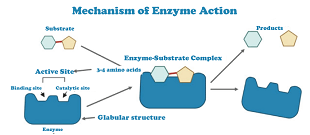Enzymes DefinitionEnzymes refer to the protein that fastens all the chemical reactions in our bodies. They play a significant role in the human body as they help digestion, liver function, and other processes. Excess or deficiency in the number of these enzymes may cause some serious health issues. These enzymes also help in detecting other diseases and illnesses. Every living being has enzymes in them. Our body has a natural process of creating enzymes, which are also produced in food and products. Enzymes build and break some elements in the body. The first stage of the metabolic process is highly dependent upon enzymes, which then react with a molecule and thus are known as substrate. Enzymes are a linear structure of amino acids which thus turns into a three-dimensional structure. This sequence of amino acids decides the type of catalytic activity to be performed by the enzyme. 
Functions of Enzymes
Types of EnzymesThere are different enzymes present in our body that play their specific role. e.g., an enzyme named carbohydrase turns carbohydrates into sugar, lipase breaks fat into fatty acids, and protease turns protein into amino acids. Enzymes are categorized into six categories:
Structure and working of an EnzymeEnzymes are seen as a lock and key model, which was proposed in 1894. The enzyme has an active site in its structure in which only a substrate will fit as a key in its lock. A new model has been introduced, known as the induced-fit model. In this model, the active site changes its shape per the requirements to fit the substrate properly. It starts its catalysis process once the substrate properly fits the active site. Each enzyme consists of an "active site". The active site is a pocket created by amino acids that perform catalysis and binds the substrate. Glutamate, Aspartate, and Histidine are some amino acid residues that act as acceptors and donors of protons. CofactorsSome cofactors are present, in the absence of which some enzymes can't work properly. These factors are non-protein molecules of two types: ions and coenzymes. Both of them attach loosely to the enzyme to support it in its functioning. The only difference between ions and molecules is that ions are inorganic molecules, whereas coenzymes are organic. When these cofactors create a tight bond with the enzyme, the term becomes known as the prosthetic group. In short, cofactors are non-protein molecules that attach to enzymes and aid them in their proper functioning. Catalysis working mechanismThere are four major working of catalysis: covalent catalysis, bond strain and catalysis, acids and bases catalysis, and orientation and proximity catalysis.
Factors affecting the activities of EnzymesProper conditions must be present to prevent the enzyme from changing its shape to fit the substrate and perform its functions properly. Enzymes generally work properly under moderate temperatures. Under high temperatures, there is a drastic drop in the activity of enzymes.
Some examples of Enzymes
Next TopicExcretion Definition
|
 For Videos Join Our Youtube Channel: Join Now
For Videos Join Our Youtube Channel: Join Now
Feedback
- Send your Feedback to [email protected]
Help Others, Please Share









